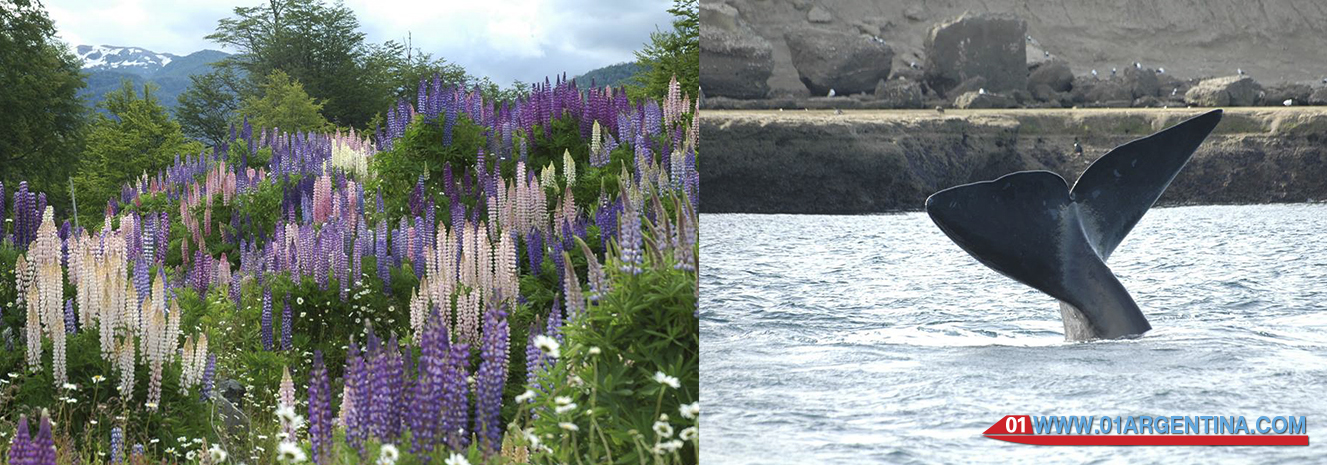Spring in Patagonia Argentina
Patagonia Whales visit the city of Puerto madryn between September and December, Patagonia also displays proud nature, charm, and color at this time, the natural life explodes once left behind winter snowfall. The melting is present and lively rivers and forests.
In the heart of three parks and seven lakes, Villa La Angostura trapping tourists throughout the year, and in spring and summer is the ideal place for outdoor activities like trekking, hiking, horseback riding or touring rivers and lakes era kayaking, canoeing, sailing or diving submerged practicing.
At that time the number of whales is large and fast-watching opportunities is greater. But even at the end of December you may be lucky enough to find some laggard specimen.
The climate is cool and windy spring, in some places can make even cold. In the mountains you can from the various ski resorts and winter sports centers. In the valleys of the mountains you will attend to the flowering of the cherry trees and different kinds of berries. On the coast, you will attend the arrival of the whales to have their young and rest in shallow water and gentle. If you dare to cross the coast you can spot colonies of hundreds or thousands of copies of penguins and sea lions.
The entrances to the Patagonia are the cities of Bariloche, in the region of lakes and mountains. Puerto Madryn on the Atlantic coast and Ushuaia on the southern tip of the continent. From there you can access hundreds of attractive places to visit.
The southern right whale species choose to broad bays and gulfs of Peninsula Valdes to rest and nurse their young. They do so in the months of June and December during the so-called whale season. Many of them come close to the shore and you can see them from the beach. If you prefer, you can also embark on ships authorized and watch as they perform their leaps out of the water in sea
The clicks of the cameras do not stop ringing, or comments astonished and movement of passengers seeking the best place not to miss a detail. The captain and assistants attend to tourists, organizing the movement of people so that nobody is left without seeing and giving explanations.
A collection of colors, aromas and flavors
Blueberries: He is known as blueberry its deep blue color. It is bittersweet, very juicy and covered with a silky skin. Connoisseurs say they have antioxidants and beneficial health properties. Most of its production in Argentina is consumed in the United States.
Raspberries: Another of the berries that are produced locally. It is reddish and also provide antioxidant benefits. It is one of the fine fruits produced in Patagonia. With her jams and preserves are produced. When traveling to Patagonia reminds taste these delicious fruits.
Blackberries: A berrie black or burgundy color and bittersweet. It contains high amounts of vitamins A and C. In some parts of the country is considered pest because of its rapid and wide dissemination.
Currants: According to your choice you can show three distinct, black, red or green colors. Its flavor is acidic and it is not regarded as fruit. It is used in culinary and industrial preparations.
Cherries: It’s one of the great Patagonian beauties. It is red and bittersweet. Experts say could prevent aging and colds. In the town of Los Antiguos, Santa Cruz, is done every month of January, the National Cherry Festival.
Rosehip: It is of European origin but spread throughout Patagonia to become almost a plague. It is grown as an ornamental plant in gardens and parks. It is of deep red color and distinctive sweetness. It is used as food and cosmetic qualities of the oil are also used.
Elder: It is black and slightly sweet taste. It is used in food and cosmetics for its emollient qualities.
Calafate: It is our great star of the Patagonian berries. It is the only native Berrie in the region. It is purplish or black and has a bittersweet taste. It was used by the natives as food and clothes to stain or paint.









